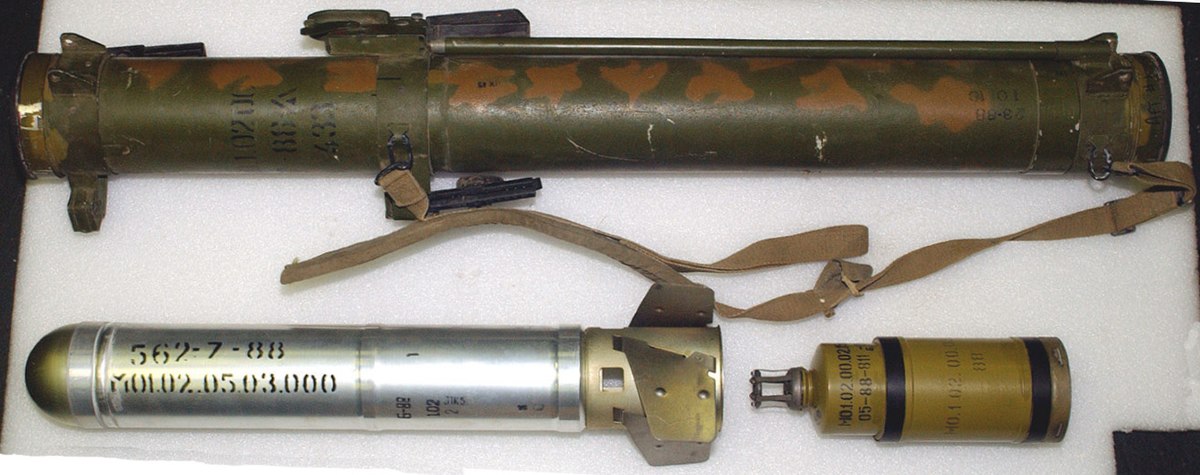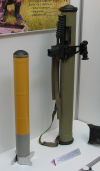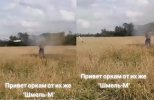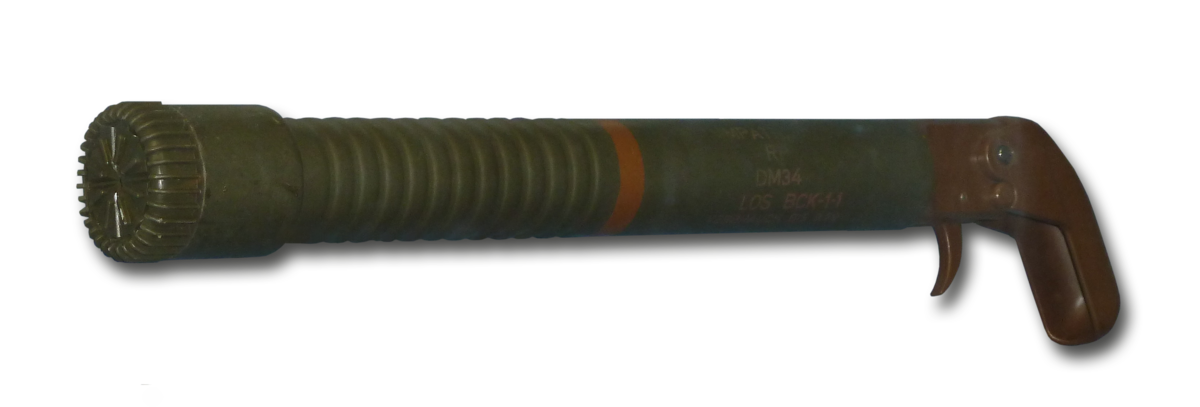RPO-A Shmel
Thermobaric rocket launcher
The formidable RPO-A Shmel is the most successful and well-known infantry thermobaric weapon to date, and is also available with smoke and incendiary warheads
Country of origin Soviet Union
Entered service 1988
Caliber 93 mm
Rocket 93 x 700 mm
Weight 11 kg
Length 920 mm
Muzzle velocity 125 m/s
Sighting range 600 m
Range of effective fire (static targets) ~ 600 m
Maximum range 1 000 m
Manufactured by Tula (now KDB), the RPO-A Shmel ("Bumblebee") is a Russian man-portable thermobaric weapon, designed to give infantry an equalizer against enemy forces holed-up in buildings and fortified structures. Officially classified as a "Flamethrower" (Reaktivnyy Pekhotnyy Ognemet = Reactive Infantry Flamethrower), the RPO-A is technically a rocket launcher similar to RPG-series weapons, but it is nonetheless suitable for many of the missions traditionally requiring a flamethrower. It is issued primarily to paratroopers, engineers, and SOF units.
It is unclear when the Soviet Army first became interested in thermobaric shoulder-launched weapons, but they had misgivings about the limitations of the
RPO Rys rocket-propelled flamethrower from itss inception, and by the early 1980s had seen a more compact thermobaric weapon as a possible solution. The development of the RPO-A began in 1984, during the Soviet-Afghan War, and perhaps due to the urgency for fielding such a weapon as quickly as possible, the first operational examples reached Soviet troops in Afghanistan in 1988.
Oddly, although the RPO-A Shmel's background is reasonably well documented (for a Cold War-era Soviet weapon), many articles discussing this weapon present inaccurate information on that subject. Many articles on the RPO-A infer that it was developed in the 1990s, or even the 2000s, but a few have mistakenly named incorrect dates or timelines. For example, the Popular Mechanics article "Terrifying Russian "Bumblebee" Flamethrower Shows Up in Syria" (published on November 4th 2015) stated that the RPO-A Shmel first saw service in 2003. Even more peculiar is the Armor Magazine article, Fuel-Air Explosives Mature by Captain Douglas Huber (featured in the November-December 2001 issue), incorrectly states the RPO-A was developed in the 1970s, and fails to even mention the RPO Rys it was developed to replace; this is rather surprising, as Capt. Huber's article was very well-sourced, and Armor Magazine is a publication of the US Army Armor School, with access to considerable US military intelligence assets. Another example was Soviet & Russian ‘flame weapons’: incendiary, thermobaric, and FAE systems in Ukraine, a November 20th 2014 article hosted by the Armament Research Services, which claimed that the RPO entered service in 2002. Such is the minefield of misleading information on the RPO-A Shmel that stretches across the internet.
The RPO-A Shmel has an extremely similar appearance to that of the earlier
RPO Rys, but is immediately distinguishable by being much shorter; the tube is relatively short for its bore, giving it a stocky appearance. The muzzle and venturi are slightly flared, but the launch tube is completely straight. There are four brackets on the tube --- one on the muzzle that holds the foregrip and forward sight, a fore-ward-middle bracket that holds the firing assembly, pistol grip, and front sling swivel; an aft-middle bracket that is apparently used for structural support (it also appears to be absent from some launcher); and a rear bracket on the venturi, which holds the rear sling swivel and the firing mechanism. The foregrip is located directly underneath the muzzle, while the main pistol grip is located in the forward mid-section and offset to the right side, and both are folded-up against the launcher when not in use. A conventional trigger is used instead of a firing bar, and the trigger group is enclosed by an oblong trigger guard. The front sight is canted upward and to the left, while the rear sight is folded-down when not in use, and has a distinctive conical hood. A narrow piece of metal stretches between the trigger mechanism in the midsection and the ignition mechanism in the breech. Some launchers have stenciling, instructional decals, or both, and the weapon may be painted in a variety of colors or camouflage patterns. The muzzle and breech are both sealed with disk-like covers, which are blown-off from the weapon before the rocket leaves the tube by its launch overpressure. The rocket is cylindrical, with a dome-like nose, four trapezoidal conformal fins that spring-out upon launch, and --- unusually --- a separate first-stage rocket motor that produces just enough thrust to propel the rocket into flight, in addition to the sustainer motor inside the projectile itself.
The tube is predominately made of reinforced fiberglass, while the brackets, sights, and trigger group are made of steel. The foregrip and pistol grip are made of solid plastic, and are usually black in color. The sling typically fitted to the RPO-A is made of canvas, and has a prominent shoulder pad. The projectile is made predominately of aluminum with a polished finish, though the nose cap and sustainer motor housing seem to be made of a different material (possibly brass); the sustainer motor itself is probably made of steel or titanium. The RPO-A is rated for an operational temperature range of −50 to +50 °C, but it has a very short shelf life of approximately 10 years.
The sights consist of a hooded front post and a hooded rear diopter. The sights are adjustable for range from 100 m to 600 m, in increments of 50 m from 100 to 200 m, and 100 m increments from 200 to 600 m, though the rocket itself will fly out to at least 1 000 m.
The RPO-A Shmel's 93x700mm rocket is built into the launcher, and both combined are issued as a single round of ammunition. This rocket is unusual among RPG-type ammunition, in that it has a two-stage propulsion system. The first stage is a cartridge which is separate from the projectile, and launches it with just enough force to propel it from the tube on a relatively flat trajectory; it expends almost all of its thrust into the projectile, substantially minimizing the weapon's backblast when fired, and then simply falls out of the tube's venturi. The second stage is a conventional solid-fuel sustainer rocket built into the projectile itself, which ignites soon after launch, expends its fuel quickly, and continues the projectile's acceleration to a high velocity.
There are three different warheads available for this rocket, and the launcher's designation differs depending on what type of payload it delivers; the RPO-A contains the aforementioned thermobaric warhead, the RPO-D contains a smoke-laying warhead, while the RPO-Z has an incendiary warhead. The weights of these rounds vary slightly, but all reportedly have an identical trajectory. In other words, a soldier experienced with using the RPO-A thus already knows exactly how to aim an RPO-D. The effect of each of these warheads is described below.
The RPO-A's projectile carries a 2.1kg thermobaric filler, which is released as an atomized cloud by a small precursor charge employing a conventional high explosive compound. In this cloud-like form, the main filler is extremely energetic and volatile, and combusts on contact with the air itself. The result is a detonation of abnormally high thermal energy and velocity (i.e., producing immense heat and pressure; hence, the "thermobaric" moniker), creating intense incendiary and blast effects over a very large area --- it is said that this warhead creates a fireball with a radius of over 6 m, and a casualty radius for the blast alone of 50 m. It is claimed by the manufacturer that this blast is equal in power to that of a 107 mm artillery piece, which is substantial for such a small munition. The effects of the blast on personnel are generally the same as those of basic high explosives, but with substantially greater trauma associated with blast overpressure; this includes internal hemorrhaging, ruptured internal organs (especially the lungs), and even broken bones, and these effects are especially pronounced and brutal against personnel inside confined areas, such as buildings, trenches or pillboxes. These make the RPO-A exceptionally effective for clearing-out enemies in closed terrain, without having to risk close quarters combat with an enemy that is likely waiting in ambush. This warhead can also be devastating against vehicles of all types (especially thin-skinned vehicles like trucks, and any armored fighting vehicles with open hatches), but thickly-armored vehicles that are buttoned-up are unlikely to sustain any internal damage. If the RPO-A hits the underside of a wheeled armored fighting vehicle (or the ground very near it), it will likely blow most of the tires and wheels off. Tracked armor is much less vulnerable to the RPO-A, but there is little doubt that any tank track could be severed by a direct hit.
The RPO-D is carries a less dramatic smoke-laying filler, which upon detonation creates a broad cloud of opaque white smoke between 55 m and 90 m long, depending on the conditions. This allows an infantry formation to immediately lay smoke at a stand-off distance, without having to wait 30 seconds or more (or possibly an hour) for mortars, artillery, or aircraft to lay smoke for them --- and they can send the projectile to the exact location of their choosing, on demand. The RPO-D can also be used in an offensive capacity, to lay smoke over enemy positions to interfere with their fire or visibility, or even to "smoke them out" (the smoke produced by this weapon has been described as irritating to the eyes and lungs in high concentrations, though not toxic). The composition of this filler has not been published, but a smoke screen this immediate and effective is typically produced by a phosphorous compound (typically white or red phosphorous); this could potentially give the RPO-D an optional incendiary effect as well, but none has been advertised by either the manufacturer or the operators of the RPO-D. At 2.3 kg, this filler is also slightly heavier than that of the RPO-A and RPO-Z.
The RPO-Z contains a 2.1 kg incendiary filler. Though instead of simple napalm, the RPO-Z's warhead is a substance known as "Pyrogel", which burns intensely from 800 to 1 000 degrees Celsius for 5-7 minutes. Pyrogel is also apparently quite volatile, given that rather than all of it being packed into a single cell, it is encased in 20 frangible pellets inside the warhead. Upon impact, the pellets are scattered and immediately ignited, spraying flaming droplets of Pyrogel across wide area. It is also rated as being highly effective when fired into structures with a volume of 90-100 cubic meters, and if goes without saying that if fired into the engine grille or fighting compartment of an armored vehicle, the resulting damage and/or casualties will be substantial.
A later product improvement program for the RPO-A resulted in a more compact version, which is claimed to produce an even *more* colossal explosion, thanks to a more modern thermobaric compound. According to KDB, the new blast produced by the RPO-M is equal in power to a 152 mm artillery shell. However, the RPO-M has evolved to the point that it is effectively a new weapon, and it is described on its own page.
The design of the RPO-A is simple enough to allow a single soldier to operate one without any support. To fire the RPO-A, the user must only raise the sights, lower the grips, shoulder the weapon, sight the target, switch-off the safety, and pull the trigger. Precautions must still be taken to ensure the backblast area is clear however, in spite of the blast-reducing design of the first stage motor --- especially if the weapon is fired from a confined space.
The trial by fire (no pun intended) for the RPO-A Shmel was during the Soviet-Afghan War. It made its debut very late in that conflict, but it was devastating against the confined fighting positions preferred by the Mujaheddin. It was reportedly referred by the Soviet soldiers as "Satan's Stick".
Though the RPO-A made soldiers using it much less vulnerable in the open than conventional flow-stream flamethrowers, and it was much more portable than the
RPO Rys, attacking a fortified bunker or cave entrance was still an extremely dangerous endeavor, no matter what weapon was used. Eliminating or displacing enemy personnel at the entrance was a simple task for the RPO-A, but actually clearing the complex required a flame soldier to actually launch a rocket into it through the entrance; this usually had to be done from directly in front of the entrance, and a Soviet soldier moving into such a position was effectively inviting snipers or machine gun positions inside the structure to cut him down. A rather interesting tactic for employing the RPO-A was developed by the Soviet Army to address these shortcomings. According to the book Afghanistan Cave Complexes 1979–2004: Mountain strongholds of the Mujaheddin, Taliban & Al Qaeda, soldiers armed with the weapon would take a position above a cave or bunker entrance, lower the weapon to the entrance on long ropes or straps, and use a long string attached to the pistol grip to fire the weapon once it was in position. This allowed soldiers armed with the RPO-A to clear a structure without the risk of being shot by enemy forces inside.
However, it was news coverage of Russia's 1990s interventions into Chechnya that brought the RPO-A Shmel into the public eye. In this conflict, it was used heavily to attack fortified structures, pillboxes, vehicle convoys, and cave complexes. It was enormously effective in these endeavors, surprising even Western observers who had known of its exploits in Afghanistan, but the RPO-A's use in Chechnya was not without incident; some were used in extremely close proximity to civilians, and many human rights organizations have accused the Russian military of indiscriminately bombarding areas known to house civilians with thermobaric weapons. It has also been further claimed by some organizations, notably Human Rights Watch, that Russian troops openly ignored the close proximity of civilians to targets they bombarded with thermobaric weapons, or that they even *deliberately* attacked civilians with them. As a result of these controversies, the RPO-A Shmel has gained a rather infamous reputation.
Russian soldiers that participated in the Third Battle of Grozny also developed another signature tactic for the RPO-A, in which soldiers armed with RPO-As, RPO-Zs, and
RPG-7s would team-up to attack armored vehicles. The grenadier with the RPG-7 would immobilize the vehicle, the soldier with the RPO-A would then inflict major damage to its exterior, likely blowing-off hatches, doors, or even armor panels, and the soldier with the RPO-Z would then fire an incendiary rocket through one of these gaps, incinerating alive all of the occupants before they could escape.
The next appearance of the RPO-A Shmel was in Sri Lanka's long and ongoing civil war, in which very large numbers were procured by the Sri Lankan Army for use against the Tamil Tigers rebel faction. The use in of the RPO-A in this conflict was similarly effective, brutal, and heavily-publicized, and resulted in many complaints of human rights abuses by the Tamil Tigers. Some of these, however, were exaggerated; notably, their claim that the use of flame weapons and thermobaric weapons was illegal under international law, and that the RPO-A is classifiable as a "chemical weapon". These particular claims are untrue, though as is also well-known that the Sri Lankan armed forces have been exceptionally heavy-handed in this war, incidents of misusing the RPO-A cannot be ruled-out.
The most recent --- publicized --- appearances of the RPO-A Shmel are in the Syrian Civil War, and the Russian intervention into Ukraine. Particularly notable is an incident on August 9th 2014, in which a Ukrainian border checkpoint building in Milove was hit by five RPO-Z rockets. Given its history, the RPO-A will likely be remembered from these conflicts as devastatingly effective, but also a hot-button issue.
The known operators of the RPO-A Shmel and its variants include Russia, Belarus, Fiji, Georgia, India, Kazakhstan, North Korea, Syria, Ukraine and Vietnam. It is unclear how many have been produced, but it is still in full-scale production. The unit cost of this weapon is 800-900 USD per piece.
Variants
RPO-A: Thermobaric version, with a 2.1 kg warhead.
RPO-D: Smoke-laying version, with a 2.3 kg warhead.
RPO-Z: Incendiary version, with a 2.1 kg warhead.
RPO-M: Improved 90 mm thermobaric version, with a more ergonomical, reloadable tube. Weighs less at 8.8 kg, and has a dramatically increased range and blast yield. Introduced into the Russian Army in 2003.
MGK Bur: Reloadable 62 mm version of the RPO-M.
Valya: This is an incendiary version of the Bur, with a similar effect to the RPO-Z.
Similar Weapons
RShG-1: Russian disposable anti-structure RPG-type weapon, based on the RPG-27, but with a thermobaric warhead instead of a shaped charge.
MRO-A Borodach: Russian disposable anti-structure RPG-type weapon employing a variant of the 72.5 mm rocket from the RPG-22, but with a thermobaric warhead instead of a shaped charge. It seems that the MRO-A was something of a stopgap for the RPO-A, but it is still in service.
M141 BDM: US disposable anti-structure RPG-type weapon with an advanced and extraordinarily powerful HEDP warhead. The M141 BDM launches a variant of the rocket from the
Mk.153 SMAW, but from a new and original launcher.
SMAW-NE: US disposable anti-structure RPG-type weapon similar to the M141 BDM, but armed with a thermobaric warhead. The SMAW-NE's blast radius and yield are enormous for a munition of its side, but the rocket itself has limited penetration capability.
MATADOR: International disposable anti-structure RPG-type weapon with a programmable HEDP warhead; the first setting causes the warhead to create a shaped charge effect like a HEAT warhead, while the alternate setting causes it to function more like a HESH warhead. It was jointly developed by companies in Israel, Singapore, and Germany.
Bunkerfaust: German disposable anti-structure based on the Panzerfaust 3 anti-tank rocket launcher, with a similar programmable HEDP warhead to that used in the MATADOR.
PF-97: Chinese disposable anti-structure RPG weapon with a thermobaric warhead, and a design astonishingly similar to the RPO-A Shmel. It may actually be derived from the RPO-A itself, but PF-97 has a smaller 80 mm bore. Little has been published about the PF-97, and it is unclear if it was ever issued in an operational capacity. It is also commonly called the Type 97.
http://www.military-today.com/firearms/rpo_a_shmel.htm







